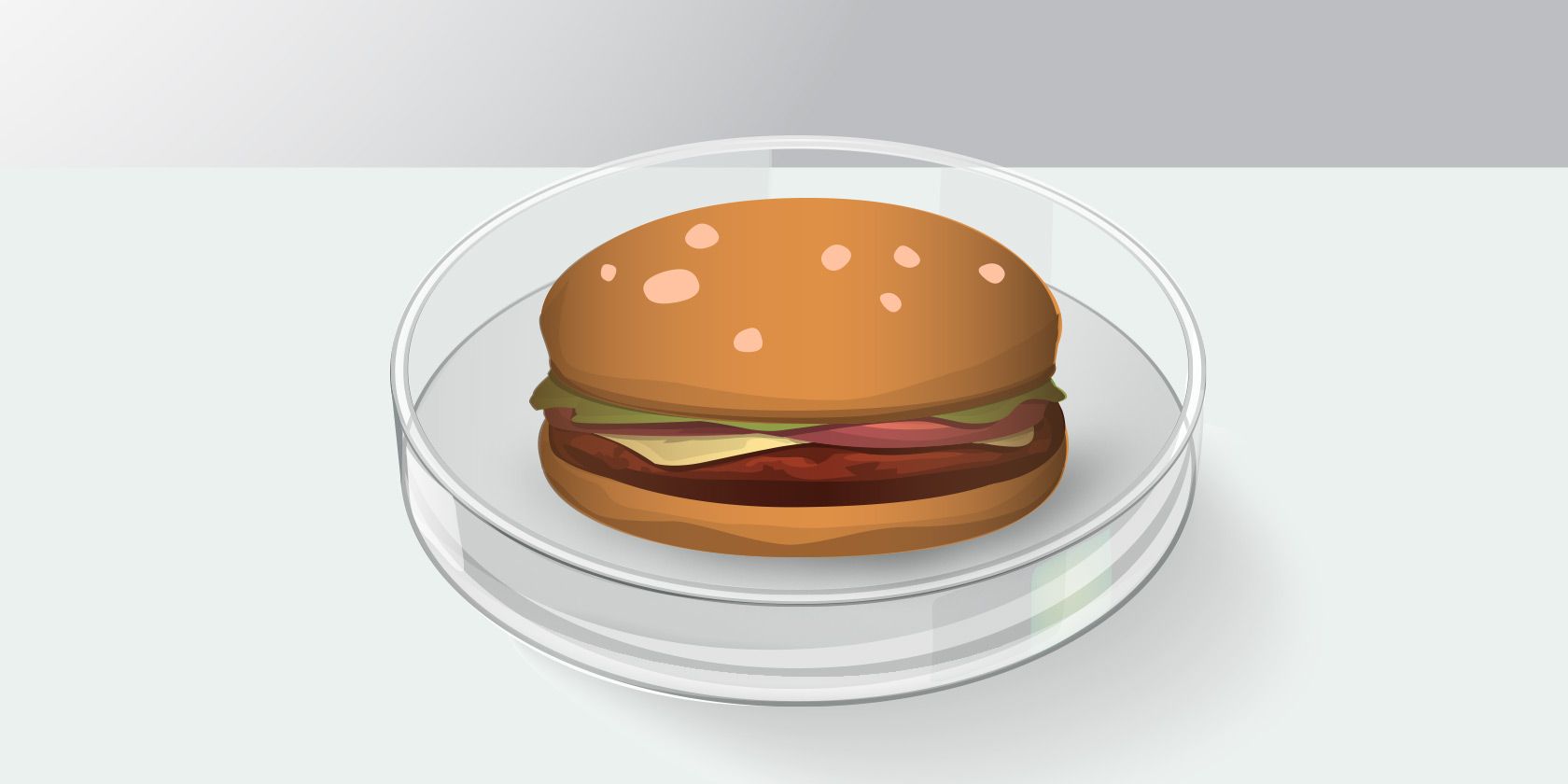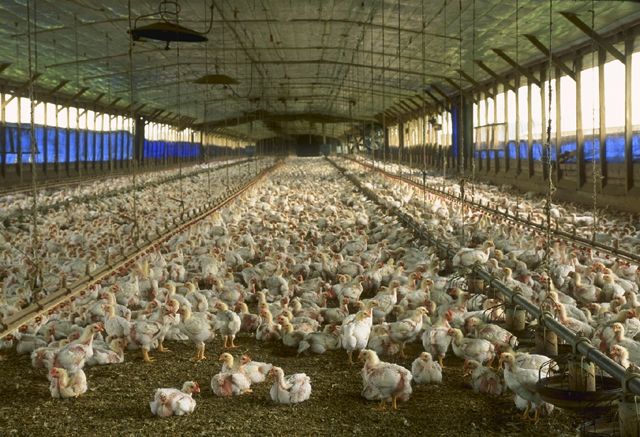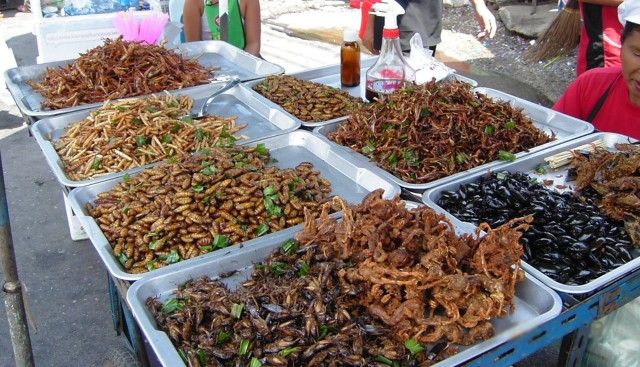Nobody is happy about the meat industry. It's cruel, expensive, and environmentally unfriendly. Producing a one-pound burger requires about thirteen pounds of grain, which carries a huge carbon footprint. It also requires raising and killing about one five-hundredth of a cow in squalid conditions, and costs a lot more than the same nutritional value in chickpeas or eggs.
If nobody ate meat, the cost of grain would fall, making it easier for the poor to survive. It would also decrease CO2 production and make the world a lot kinder and fluffier. Which would be all well and good, except that meat is delicious and nobody is giving it up without a fight. So -- what do we do about this dilemma?
The UN, in its own inimitable style, has proposed that the first world eat efficient, eco-friendly insects. Some countries around the world use mealworms, crickets, flies, and beetles as dietary staples. This plan suffers from a lack of realism.
Insects' bulky exoskeletons give them an unpleasant chitinous texture that's alien to Western palettes. Expecting the dietary habits of whole continents to suddenly shift to an unpleasant and alien foodstuff for abstract environmental reasons is ridiculous. If environmentalists can't sell people on the merits of vegetarianism, I'm not sure why they expect cockroaches to be an easier sell.
The Meat* Revolution
Luckily, there's is a more practical solution to the problem in the works, in the form of an emerging technology based on tissue cloning. The technology is going to be cheap, green, and you won't have to eat any mealworms. It's called "lab grown meat" and it allows for the creation of animal muscle tissue in an eco-friendly and cruelty-free fashion. The technology is similar to that being developed to create artificial organs. The project to develop the meat is being bankrolled by Google founder Sergey Brin to the tune of millions of dollars.
Here's an excellent rundown of the technology as of two years ago:
About a year later, the first lab-grown hamburger (which cost a little less than $350,000), was created over a period of three months, and fed to some professional food tasters. The tasters declared that the burgers tasted and felt like meat, if a little dry. The dryness was due to the lack of fat cells in the meat, which are more complex to culture than conventional muscle cells. The high cost was because the meat has to be cultured in small fibers to ensure that oxygen and nutrition can reach them.
The first burger was a proof of concept, and one with a lot of caveats: the meat was expensive, and the lack of fat limited its flavor and nutrition. However, since then, there's been rapid progress. The head of the project, Mark Post, now estimates that the meat can be produced for about $80 per kilogram, or $36.00 per pound. If you do the math, that means that a quarter-pounder burger patty, using the lab-grown beef, would cost about $9.00. That's still almost ten times more expensive than traditional beef, but it's also a huge leap compared to that first burger.
There's also a lot of possible improvements on the horizon. Techniques have already been developed to create artificial veins in synthetic organs. The same technology could be used to grow larger (and more structured) pieces of meat, which would reduce the cost and complexity of making lab-grown beef in quantity.
It's also worth noting that the current process is far from mass-production. Large-scale fabrication would also allow manufacturers to exploit economies of scale to bring prices down much further. In the long run, because so much less raw material is required, it should be possible to create meat that is quite a bit cheaper than the natural variety. Dr. Post recently gave a talk to a Cattleman's Association in Australia, in which he warned them that their business model could be disrupted by lab-grown meat in the near future.
"I do think that in 20, 30 years from now we will have a viable industry producing alternative beef. [...] I think we seriously need to consider that this is going to be an alternative. [...] Even if I am not going to do it, others will do it at some point. It is just too obvious a possibility."
In the near term, Post's focus is on solving basic technical problems with lab-grown meat: learning to culture fat tissue, improving yield, and eliminating the animal by-products that he's using to culture the cells, replacing them with synthetic and plant-based alternatives. He believes this work can be completed in the next few years. From there, the technology can begin to leverage 3D printing technology to create more structured meats (like steak), and to other kinds of meat (including fish, chicken, and turkey).
Will People Eat It?
Some people are freaked out by the idea of lab-grown meat. This is a hard perspective for me to understand. I grew up on a farm, and I barely get through the day by ignoring what I know about where food comes from. If I know for sure that my burger was produced in a sterile vat with absolutely no screaming, it would be a huge load off my mind. Growing stem cells in bioreactor using plant protein seems like a less squicky option than keeping a cow standing in feces in a concrete closet.
Maybe it's a question of marketing. "Lab grown meat" hits some pretty scary buttons for many Americans. Perhaps "zero-cruelty beef" would go over better. Or maybe it's better not to talk about it at all -- disclose whatever minimum amount of information that the FDA decides is necessary and let cost-competition drive adoption.
Regardless, I hope these issues can be settled before the technology hits the market. If this technology can reach the mass market, it would help a lot of people. Ethical vegetarians can eat meat guilt-free -- PETA has a one million dollar prize for the first company to develop inexpensive lab-grown chicken. Conservative Jews and Muslims can eat cloned bacon without worry. When the cost falls far enough, poor people who rely on cheap-but-unhealthy carb-heavy diets will have more affordable access to meat, helping to reduce both malnutrition and the obesity crisis.
What do you think? Are you up for eating some cultured beef? Let me know in the comments!
Image Credit: Petri dish Via Shutterstock, "Hamburger", by Wikimedia, "Insect Food Stall," by Wikimedia, "Chicken Farm," by Wikimedia




